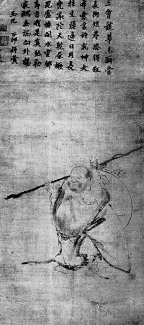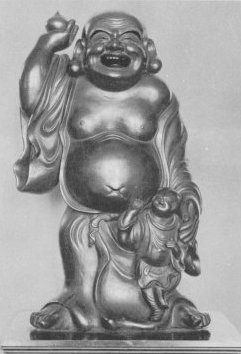
Seven Gods of Good Luck

The above is a print showing the Treasure Ship (also known as the Ship of Riches) with the Seven Gods of Good Fortune, showing their emblems, the sacred treasures, and other tokens of good luck for the new year. The upper row gods are:
1. Fukurokuju, male. God of wealth and longevity, bearded, usually seen holding a stick with a sutra scroll attached to it. May have cranes and/or a tortoise near him. He wears the robe of a scholar. He is a Chinese hermit, also said to be the god of the south polar star. The stork is his messenger. He could prophesy events.
2. Benzaiten (also called Benten): female, usually shown seated on a dragon or serpent and playing a lute. She is the Indian angel Sarasvati. She is the goddess of eloquence and the arts. She represents literature, music and eloquence. Maidens who wish to improve in female accomplishments are her devoted worshipers.
3. Bishamonten (also called Bishamom), male, the god of warriors, in armor and holding a spear in one hand and a pagoda in the other. He is the Indian deity Valsrayana. The centipede is his messenger. Scourge of evil-doers. The toy pagoda he carries indicates his dual role of religious missionary and warrior, determined to conquer the world through the virtues of his spear and the pagoda.
In the front row are the following:
4. Hotei, the god of contentment and happiness, male. He's fat, has a large stomach and a happy face. Carries a bag on his back and holds a fan called an oogi He is supposedly a human. The fat stomach is to indicate a largeness of soul and an inward wealth of resources, characteristic of a man who has attained the wisdom of Buddhism. Is is a mendicant priest called Keishi who lived in China during the Tang dynasty. He owned hardly anything but the personal effects contained in a large bag that he is represented always to carry on his back, living entirely on alms.

The wondering monk Hotei, the artwork done by Mokuan The monk is happy because he has found peace in the study of Zen.

Another piece of artwork relating to Hotei. This one is by Nishimura Shigenaga 1697-1756. In this one Hotei is carrying a lady across a stream.

This is a Bizen stoneware image of Hotei. He is shown with a child by his side, the sacred gem in his right hand and a bag into which he puts playful children or the sacred treasures.
5. Daikoku, male, god of wealth, patron saint of farmers, a disseminator of good humor and happiness. He is a combination of the Indian deity Mahakala and the Japanese prehistoric prince Okuninushi. The rat is his messenger. Wears a hood and sits on bales of rice, carrying a bag full of treasures over his shoulder and holding a small mallet. The mallet is called an uchide-no-kozuchi and is lucky.
6. Ebisu (also called Yebisu), male, the god of fishermen, said to be the third child of Prince Izanagi and Princess Izanamai, and brother of the ancestress of the Imperial family of Japan. . Smiling, dressed in court robes, holds a large red sea bream in one hand and has a fishing rod placed over his shoulder. He is considered an honest worker who earns his living by honest toil.
7. Jurojin, male. God of longevity, has long white bear, carries holy staff with sacred scroll and holds a fan. He is also dressed in the robe of a scholar. He is a copious drinker of sake. The sacred scroll contains all the wisdom of the world. Said to be identical with Fukuroju and added only to make the lucky number of seven. The deer is his messenger.
The ideogram on the boat's sail is kotobuki which means hope, happiness, long life, good fortune, and so forth.
There is a Japanese song about the ship which goes:
It is a long night.
The gods of luck sleep.
They all open their eyes.
They ride in a boat on the waves.
The sound is pleasing.
Main Index
Japan main page
Japanese-American Internment Camps index page
Japan and World War II index page
|